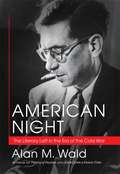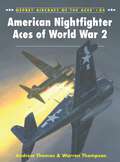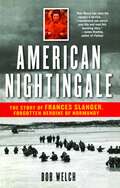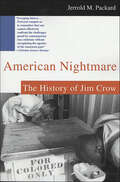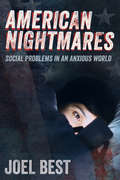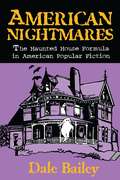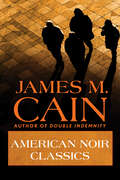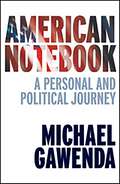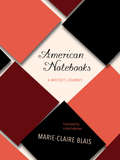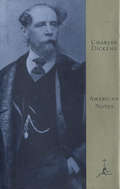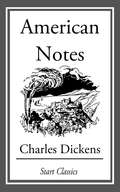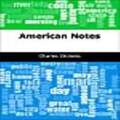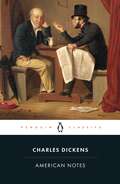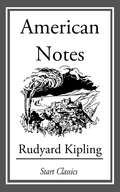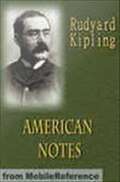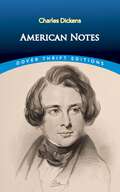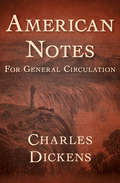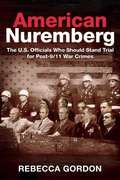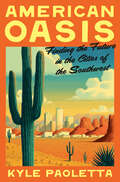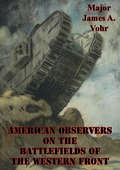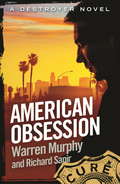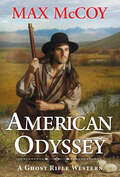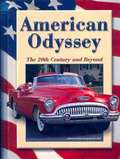- Table View
- List View
American Night
by Alan M. WaldAmerican Night, the final volume of an unprecedented trilogy, brings Alan Wald's multigenerational history of Communist writers to a poignant climax. Using new research to explore the intimate lives of novelists, poets, and critics during the Cold War, Wald reveals a radical community longing for the rebirth of the social vision of the 1930s and struggling with a loss of moral certainty as the Communist worldview was being called into question. The resulting literature, Wald shows, is a haunting record of fracture and struggle linked by common structures of feeling, ones more suggestive of the "negative dialectics" of Theodor Adorno than the traditional social realism of the Left. Establishing new points of contact among Kenneth Fearing, Ann Petry, Alexander Saxton, Richard Wright, Jo Sinclair, Thomas McGrath, and Carlos Bulosan, Wald argues that these writers were in dialogue with psychoanalysis, existentialism, and postwar modernism, often generating moods of piercing emotional acuity and cosmic dissent. He also recounts the contributions of lesser known cultural workers, with a unique accent on gays and lesbians, secular Jews, and people of color. The vexing ambiguities of an era Wald labels "late antifascism" serve to frame an impressive collective biography.
American Nightfighter Aces of World War 2
by Chris Davey Warren ThompsonThe Americans lagged behind their European contemporaries in military aviation in the late 1930s, and it took the Battle of Britain to awaken an isolated America to the necessity of having aircraft that could defend targets against nighttime attack by bomber aircraft. With the help of the RAF, the importance of creating such a specialized fighter force was given top priority. This book examines the numerous aircraft types that were used by the US in this role, beginning with the early 'stop-gap' conversions like the TBM Avenger, Lockheed Ventura and the A-20 Havoc (P-70). It goes on to detail the combat history of the newer and radar equipped Hellcats, Corsairs and Black Widows that were designed to seek out enemy aircraft (both German and Japanese) in Europe, the Mediterranean and the Pacific. It was these aircraft that registered most of the kills made by the Navy, Marine Corps and USAAF in 1944-45. Finally there are additional accounts from the American pilots who spent time on the frontline on exchange tours with the RAF in the ETO/MTO, learning the intricacies of flying radar-equipped fighters like the Mosquito and Beaufighter at night, prior to the USAAF taking receipt of the much-delayed P-61. With full color profiles and rare photographs, this is an absorbing account of an often underestimated flying force: the American Nightfighters.
American Nightingale: The Story of Frances Slanger, Forgotten Heroine of Normandy
by Bob WelchOf the 350,000 American women in uniform during World War II, none instilled more hope in American GIs than Frances Slanger. In Army fatigues and helmet she splashed ashore with the first nurses to hit the Normandy beach in June 1944. Later, from a storm-whipped tent amid the thud of artillery shells, she wrote a letter to Stars and Stripes newspaper that would stir the souls of thousands of weary soldiers. Hundreds wrote heartfelt responses, praising Slanger and her fellow nurses and honoring her humility and patriotism. But Frances Slanger never got to read such praise. She was dead, killed the very next day when German troops shelled her field hospital, the first American nurse to die in Europe after the landing at Normandy. Frances Slanger was a Jewish fruit-peddler's daughter who survived a chilling childhood in World War I-torn Poland and immigrated to America at age seven. Inspired by memories of her bitter past and a Nazi-threatened future, she defied her parents' wishes by becoming a nurse and joining the military. A woman of great integrity and courage, she was also a passionate writer and keeper of chapbooks. This is the story of her too brief life.
American Nightmare: The History of Jim Crow
by Jerrold M. Packard“A very powerful and unsettling story of our nation’s century-long ‘pogrom’ by vengeful white Southerners against their black neighbors.” —The Washington TimesFor a hundred years after the end of the Civil War, a quarter of all Americans lived under a system of legalized segregation called Jim Crow. Together with its rigidly enforced canon of racial “etiquette,” these rules governed nearly every aspect of life—and outlined draconian punishments for infractions.The purpose of Jim Crow was to keep African Americans subjugated at a level as close as possible to their former slave status. Exceeding even South Africa’s notorious apartheid in the humiliation, degradation, and suffering it brought, Jim Crow left scars on the American psyche that are still felt today. American Nightmare examines and explains Jim Crow from its beginnings to its end: how it came into being, how it was lived, how it was justified, and how, at long last, it was overcome only a few short decades ago. Most importantly, this book reveals how a nation founded on principles of equality and freedom came to enact as law a pervasive system of inequality and virtual slavery.Although America has finally consigned Jim Crow to the historical graveyard, Jerrold Packard shows why it is important that this scourge—and an understanding of how it happened—remain alive in the nation’s collective memory.“Sweeping history . . . Packard compels us to remember that one cannot effectively confront the challenges posed by contemporary race relations without recognizing the agonies of the American past.” —The Christian Science Monitor
American Nightmares: Social Problems in an Anxious World
by Joel BestIn an accessible and droll style, well-known sociologist Joel Best shines a light on how we navigate these anxious, insecure social times. While most of us still strive for the American Dream—to graduate from college, own a home, work toward early retirement—recent generations have been told that the next generation will not be able to achieve these goals, that things are getting—or are on the verge of getting—worse. In American Nightmares, Best addresses the apprehension that we face every day as we are bombarded with threats that the social institutions we count on are imperiled. Our schools are failing to teach our kids. Healthcare may soon be harder to obtain. We can’t bank on our retirement plans. And our homes—still the largest chunk of most people’s net worth—may lose much of their value. Our very way of life is being threatened! Or is it? With a steady voice and keen focus, Best examines how a culture develops fears and fantasies and how these visions are created and recreated in every generation. By dismantling current ideas about the future, collective memory, and sociology’s marginalization in the public square, Best sheds light on how social problems—and our anxiety about them—are socially constructed.
American Nightmares: The Haunted House Formula in American Popular Fiction
by Dale BaileyWhen Edgar Allan Poe set down the tale of the accursed House of Usher in 1839, he also laid the foundation for a literary tradition that has assumed a lasting role in American culture. "The House of Usher" and its literary progeny have not lacked for tenants in the century and a half since: writers from Nathaniel Hawthorne to Stephen King have taken rooms in the haunted houses of American fiction. Dale Bailey traces the haunted house tale from its origins in English gothic fiction to the paperback potboilers of the present, highlighting the unique significance of the house in the domestic, economic, and social ideologies of our nation. The author concludes that the haunted house has become a powerful and profoundly subversive symbol of everything that has gone nightmarishly awry in the American Dream.
American Noir Classics
by James M. CainA collection of hardboiled crime fiction from the author of Double Indemnity, “one of the greats of American noir” (The Guardian). They call him Lucky—but he’s never had a lucky day in his life. A nineteen-year-old hobo just starting to ride the rails, he is hiding in the coal car when the railroad detective comes through. They get into a scuffle, and Lucky’s hand finds a railroad spike. . . .“Dead Man” is just one of the outstanding stories in this collection by the author renowned for insightful and exciting crime stories. Hailed as a “poet of the tabloid murder” by legendary critic Edmund Wilson and a Mystery Writers of America Grand Master, James M. Cain, understood fear in all its forms—and knew better than anyone the terror of a killer on the run. This volume includes:“The Baby in the Icebox” • “Pay-Off Girl” • “Two o’Clock Blonde” • “The Birthday Party” * “Brush Fire” • “Coal Black” • “Career in C Major” • “Death on the Beach” • “Dead Man” • “The Girl in the Storm” • “Joy Ride to Glory” • “Pastorale” • “Mommy’s a Barfly” • “The Taking of Montfaucon” • “Cigarette Girl” • “The Robbery” • “Blackmail”
American Nonpublic Schools: Patterns of Diversity
by Otto F. KraushaarThis book is about the nonpublic or private schools of America--their history, goals, significance, problems, and prospects. It was undertaken in the belief that these schools, which at their crest educated approximately 6.5 million children in about 19 thousand elementary and secondary schools, constitute an important resource in America's dual system of public and private schooling, a resource which is currently in serious jeopardy.
American Notebook: A Personal and Political Journey
by Michael GawendaOne of the rewards extended to former editors—if they are lucky and get to plan their departure—is that they can choose their next assignment. I had no doubt about what I wanted: to be Washington correspondent for The Age and The Sydney Morning Herald. There was no more important and interesting international story to cover than the United States at the beginning of George W. Bush's second term. The war in Iraq was going badly, and it was not at all clear that the war on terror was being won—or even if there was any agreement that it was, in fact, a war. When veteran journalist Michael Gawenda was posted to the USA as a Washington correspondent in 2005, George W. Bush was beginning his second term, and the war in Iraq was showing signs of becoming a quagmire. Two years later, Bush is a lame duck president and most Americans want their troops out of Iraq. American Notebook is Gawenda's absorbing and insightful account of his American posting. Weaving the personal into the political, Gawenda takes the reader on his journey into a country he has always loved. Beyond daily life in Washington, he visits hurricane-ravaged New Orleans and the God-fearing states of the Midwest. His engaging analysis of politics and current events is interwoven with his reflections on his childhood as a post-war Jewish refugee, growing up in the sixties in a Melbourne steeped in American culture. In light of the increasingly evident failure of efforts in Iraq, he revisits his own controversial decision while editor of The Age newspaper to support the Howard Government's decision in 2003 to join the coalition of the willing. American Notebook is a fascinating discussion of the role of journalism and the nature of public debate about war, politics and current events.
American Notebooks: A Writer's Journey
by Marie-Claire BlaisIt is the spring of 1963. The young Quebec author Marie-Claire Blais, bursting with energy and talent, has just won a coveted Guggenheim fellowship. She chooses Cambridge, Massachusetts, as the place where she will begin her writer's apprenticeship with her mentor, Edmund Wilson. American Notebooks is much more than a fascinating autobiographical account of the intellectual flowering of a great writer. An album of exquisitely drawn literary portraits of companions, intellectuals, writers, musicians, artists and social activists of the period--Edmund and Elena Wilson; Mary Meigs; Maud Maugan; Barbara Deming; Truman Capote; Jacques Hébert, her first Quebec publisher, then senator; and many others--it also introduces many of the real life personalities who have inspired her fictional characters.
American Notes
by Charles DickensWhen Charles Dickens set out for America in 1842 he was the most famous man of his day to travel there - curious about the revolutionary new civilization that had captured the English imagination. His frank and often humorous descriptions cover everything from his comically wretched sea voyage to his sheer astonishment at the magnificence of the Niagara Falls, while he also visited hospitals, prisons and law courts and found them exemplary. But Dickens's opinion of America as a land ruled by money, partly built on slavery, with a corrupt press and unsavoury manners, provoked a hostile reaction on both sides of the Atlantic. American Notes is an illuminating account of a great writer's revelatory encounter with the New World.
American Notes
by Charles DickensCharles Dickens was the most famous of many travelers of his time who journeyed to America, curious about the revolutionary new civilization that had captured the English imagination. His frank, often humorous descriptions in his 1842 account cover everything from his uncomfortable sea voyage to an ecstatic narrative of his visit to Niagara Falls. Yet Dickens is also critical of American society, its preoccupation with money, and reliance on slavery, as well as the rude, unsavory manners of Americans and their corrupt press. Above all, American Notes is a lively chronicle of what was for Dickens an illuminating encounter with the New World.
American Notes
by Charles DickensTrajectory presents classics of world literature with 21st century features! Our original-text editions include the following visual enhancements to foster a deeper understanding of the work: Word Clouds at the start of each chapter highlight important words. Word, sentence, paragraph counts, and reading time help readers and teachers determine chapter complexity. <P> <P> Co-occurrence graphs depict character-to-character interactions as well character to place interactions. Sentiment indexes identify positive and negative trends in mood within each chapter. Frequency graphs help display the impact this book has had on popular culture since its original date of publication. Use Trajectory analytics to deepen comprehension, to provide a focus for discussions and writing assignments, and to engage new readers with some of the greatest stories ever told. "American Notes" by Charles Dickens is an account of Dickens' five month trip across America and Canada in 1842. Read this story to get a humorous and honest portrayal of life in America in the 19th century!
American Notes
by Charles Dickens'Like Shakespeare, Dickens was able to embrace a whole world' John MortimerWhen Charles Dickens set out for America in 1842, he was the most famous man of his day to make the journey, and embarked on his travels with an intense curiosity. His frank descriptions cover everything from his comically wretched sea voyage to his sheer astonishment at Niagara Falls, while he also visited hospitals, prisons and law courts. But Dickens's depiction of America as a land ruled by money, built on slavery, with a corrupt press and unsavoury manners, provoked a hostile reaction on both sides of the Atlantic. American Notes is an illuminating account of a great writer's revelatory encounter with the New World.Edited with an Introduction and Notes by Patricia Ingham
American Notes
by Rudyard KiplingIt is hardly fair to Mr. Kipling to call American Notes first impressions, for one reading them will readily see that the impressions are superficial, little thought being put upon the writing. They seem super-sarcastic, and would lead one to believe that Mr. Kipling is antagonistic to America in every respect. This, however, is not true. These Notes aroused much protest and severe criticism when they appeared in 1891, and are considered so far beneath Mr. Kipling's real work that they have been nearly suppressed and are rarely found in a list of his writings.
American Notes
by Rudyard KiplingThis is what Bret Harte has written of the great city of San Francisco, and for the past fortnight I have been wondering what made him do it. There is neither serenity nor indifference to be found in these parts; and evil would it be for the continents whose wardship were intrusted to so reckless a guardian. Behold me pitched neck-and-crop from twenty days of the high seas into the whirl of California, deprived of any guidance, and left to draw my own conclusions. <P> <P> Protect me from the wrath of an outraged community if these letters be ever read by American eyes San Francisco is a mad city--inhabited for the most part by perfectly insane people, whose women are of a remarkable beauty. .
American Notes: Digital Reprint Of 1895 International Book Co. Edition (Dover Thrift Editions)
by Charles Dickens"This is not the republic of my imagination," Charles Dickens noted ruefully of his 1842 visit to the United States. His American Notes forms a stinging reproof of the country's embrace of slavery, its corrupt press and woeful sanitary conditions, and its citizens' offensive manners. Written with the author's customary observational powers and incisive wit, this volume offers a fascinating glimpse of 19th-century America. Dickens was not entirely hostile toward his hosts, and as a dedicated social reformer he took particular interest in whether American democracy constituted an advance over the class divisions of Victorian England. The author toured jails, hospitals, and courts of law, which he praised heartily. Traveling by steamship, coach, and rail, he visited New York, Philadelphia, Boston, and Washington, D. C., among other cities, and his utter astonishment at the natural grandeur of Niagara Falls marks a highlight of his travelogue. This trenchant satire of America and Americans is certain to delight both Dickens enthusiasts and history buffs.
American Notes: For General Circulation (Modern Library Series #Vol. 1)
by Charles DickensA travelogue detailing Charles Dickens's tour of North America In January of 1842, Charles Dickens and his wife, Kate, traveled from Liverpool to Boston. At the time, Dickens had already attained a tremendous level of literary success and fame, and the author hoped his travels would help him gain insight into the New World that had captivated the English imagination. Over the ensuing 6 months, Dickens explored the East Coast and Great Lakes regions of the United States and Canada, observing life on the opposite side of the Atlantic from a distinctly British viewpoint. By turns humorous, critical, witty, and incisive, this travelogue is a unique and keen look at 19th-century North America. This ebook has been professionally proofread to ensure accuracy and readability on all devices.
American Nuremberg: The U.S. Officials Who Should Stand Trial for Post-9/11 War Crimes
by Rebecca GordonAmerica goes on trial for war crimes in this persuasively argued book from the author of Mainstreaming Torture. In the aftermath of 9/11, the Bush administration initiated a war on terror that systematically violated international law. In the name of national security, the United States government established secret detention centers (aka “black sites”) and carried out torture, extraordinary rendition, drone assassinations, and massive surveillance of its own citizens. Though there is overwhelming evidence of these human rights violations, no action has been taken to pursue justice for the victims. No high US official has been charged for enacting these policies, considered by legal experts around the world to be war crimes. Between 1945 and 1949, the United States and its allies put nearly two hundred Nazi war criminals on trial, a towering political achievement that established the legitimacy of international law. Philosopher and ethicist Rebecca Gordon argues that America must now either apply the same principles to its own officials or risk undoing its legacy as leader of the free world. In American Nuremberg, she not only makes a compelling case for the prosecution, but also lays out the legal groundwork that would make such a tribunal possible in our time.
American Nursing: A History of Knowledge, Authority, and the Meaning of Work
by Patricia D'AntonioFirst Place, History and Public Policy, 2010 American Journal of Nursing Book of the Year AwardsThis new interpretation of the history of nursing in the United States captures the many ways women reframed the most traditional of all gender expectations—that of caring for the sick—to create new possibilities for themselves, to renegotiate the terms of some of their life experiences, and to reshape their own sense of worth and power. For much of modern U.S. history, nursing was informal, often uncompensated, and almost wholly the province of female family and community members. This began to change at the end of the nineteenth century when the prospect of formal training opened for women doors that had been previously closed. Nurses became respected professionals, and becoming a formally trained nurse granted women a range of new social choices and opportunities that eventually translated into economic mobility and stability. Patricia D'Antonio looks closely at this history—using a new analytic framework and a rich trove of archival sources—and finds complex, multiple meanings in the individual choices of women who elected a nursing career. New relationships and social and professional options empowered nurses in constructing consequential lives, supporting their families, and participating both in their communities and in the health care system. Narrating the experiences of nurses, D'Antonio captures the possibilities, power, and problems inherent in the different ways women defined their work and lived their lives. Scholars in the history of medicine, nursing, and public policy, those interested in the intersections of identity, work, gender, education, and race, and nurses will find this a provocative book.
American Oasis: Finding the Future in the Cities of the Southwest
by Kyle PaolettaAn expansive and revelatory historical exploration of the multicultural, water-seeking, land-destroying settlers of the most arid corner of North America, arguing that in order to know where the United States is going in the era of mass migration and climate crisis we must understand where the Southwest has already beenAlbuquerque. Phoenix. Tucson. El Paso. Las Vegas. Iconic American cities surrounded by desert and rust. Teeming metropolises that seem to exist independently of the seemingly inhospitable and arid landscape that surrounds them, belying the rich insight they offer into American stories of migration, industry, bloodshed, and rebirth. Charting a geographic path through America's largest and hottest deserts, acclaimed journalist Kyle Paoletta maps the past and future of these cities, and the many other settlements from rural town to urban sprawl that make up the region that has come to be called &“the American Southwest.&” Weaving together the stories of immigrants and indigenous populations, American Oasis pulls back the layers of settlement, sediment, habit, and effect that successive empires have left on the region, from the Athapascan, Diné, Tewa, Apache, and Comanche, to the Spanish, Mexican, and, finally, American. As Paoletta&’s journey into the Southwest&’s history becomes inextricably linked to an exploration of its dependency on water, he begins to ask: where, ultimately, will cities like Las Vegas and Phoenix find themselves once the Colorado River and its branches dry up? Richly reported and sweeping in its history, American Oasis is the story of what one iconic region&’s past can tell us about our shared environmental and cultural future.
American Observers On The Battlefields Of The Western Front
by Major James A. Vohr USMCAlthough during World War I the United States employed observers on the battlefields of the Western Front, the information they provided lacked the substance and conclusions required to evolve the tactical doctrine of the American Expeditionary Forces (AEF). In initial engagements, the AEF was largely forced to rely, with predictable negative outcome, upon outdated concepts founded largely upon the prejudices of the Army's leadership.In August of 1914 the United States Army and Marine Corps demonstrated strong foresight, considering the isolationist perspective of the nation, in detailing officers to the battlefields of Europe. These officers were given little guidance, but their mission was clearly to report on military actions and developments in what was becoming the largest struggle in history. A significant military development of World War I noted by the U.S. was the advance of offensive infantry tactics to cope effectively with the characteristics and lethality of the modern battlefield.The United States, with a two and one-half year opportunity to observe tactics prior to the engagement of the AEF, arguably should have benefited from the experience of others. However, this was not the case. The AEF in its initial engagements, performed much as its European counterparts did at the onset of the war. Eventually the AEF performance improved, but only as U.S. soldiers and Marines gained personal battlefield experience.
American Obsession: Number 109 in Series (The Destroyer #109)
by Warren Murphy Richard SapirThe new body culture is finally bringing its rewards, thanks to a hormone treatment that rapidly restructures body fat to muscle, all overnight, during a true beauty snooze.But it's way-out expensive, and only the rich and famous can indulge. After all, what's a thousand bucks a day when the result is a body to die for?There are some side effects - no pain, no gain! But when innocent people start paying a steep price for the stars' self-improvement regimens, CURE's Dr. Smith sends Remo and Chiun to infiltrate the Lycra crowd and the hallowed halls of the legalized drug trade. Soon their investigation is blocked by a greedy corporation, but the worst challenge is from an army of celebrities - lean, mean products of a killer diet....Breathlessly action-packed and boasting a winning combination of thrills, humour and mysticism, the Destroyer is one of the bestselling series of all time.
American Odyssey (A Ghost Rifle Western #2)
by Max McCoyMax McCoy, the Spur Award-winning author of Damnation Road, continues his American Western saga of the Ghost Rifle as the violence and bloodshed the weapon caused return to haunt the man who created it . . .THE WEAPON AND THE WILDERNESS Ten years have passed since Jack Picaro lost his Ghost Rifle—the firearm he invented, the one that never missed its target. The loss of the rifle calmed the hellraiser in his soul. Instead of returning to the gambling halls and whiskey bars of St. Louis, Jack has spent the last decade as a fur trapper in Wyoming&’s Wild River Range, married to Sky, the daughter of an Arikara war chief. Then, after helping rescue U.S. soldiers captured by Crow Indians in the Rocky Mountains, Jack hears the familiar bell-like report of his Ghost Rifle. Determined to retrieve his deadly property, he travels deep into Lakota territory, facing down old enemies—and resuming old sinful habits—unaware of what awaits him when he eventually returns home to his family.&“Few Western writers today can spin a tale with style, wit, and rawness better than Max McCoy.&”—Johnny D. Boggs, Western Heritage and Spur Award-winning author of West Texas Kill
American Odyssey: The 20th Century and Beyond
by Gary B. NashThe book covers relationships, interprets evidence, and connects the present to the past--that's what history is all about.
